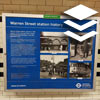LONDON UNDERGROUND HISTORY
Camden Town station history Find out more at
www.ltmuseum.co.uk The Charing Cross, Euston, and Hampstead Railway - a forerunner of today’s Northern line - opened Camden Town station in 1907.
It was designed as an interchange from the start, serving as the point where customers going north could transfer between services. One branch went to Highgate (the current Archway station) and one branch went to Hampstead.
The station was designed by architect Leslie Green, and features the oxblood terracotta faience tile exterior and half-moon windows that are a trademark of his station designs.
In the early 1920s, services from the City and South London Railway began calling at the station, creating the shape of today’s Northern line. Customers heading south could change here for services on either the Charing Cross or Bank branches.
In October 1940, the station was damaged during the Blitz. While the station entrance was unscathed, one side of the station was destroyed.
There are some hidden gems in the station. At the Kentish Town Road entrance, you can see a triangular-shaped frame which is an original Edwardian advertising board, and above each entrance is a metal roundel silhouette. Original ’To Highgate’ tiling can be found on the way to the platforms.
In a typical year, more than 20 million journeys start or end at Camden Town station.
[Images]
c.1915: The Leslie Green-designed station was topped by a privately owned billiard club
1924: A signaller operates the levers controlling the complex Camden junction
1936: London Transport staff relax in the canteen above the station. Note the half-moon windows to the left
1940: This image shows the damage to the station following an air raid
MAYOR OF LONDON
Logo of the Underground
TRANSPORT FOR LONDON - EVERY JOURNEY MATTERS
© TFL courtesy of the London Transport Museum
51


 Click for all signs belonging to London Underground History
Click for all signs belonging to London Underground History
 904 Meter |
904 Meter |  1.42 Km |
1.42 Km |  1.42 Km |
1.42 Km |  1.67 Km |
1.67 Km |  2.06 Km
2.06 Km